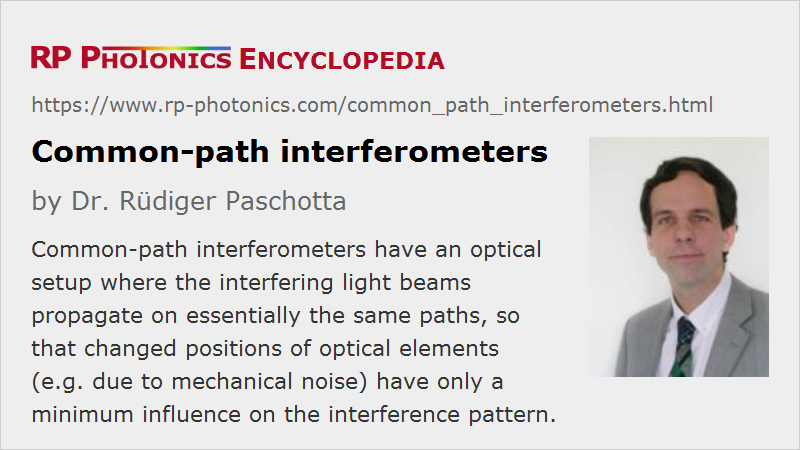Common-path Interferometers
Definition: interferometers where the sensitivity to mechanical noise is reduced by largely using a common optical path for the interfering light beams
More general term: interferometers
How to cite the article; suggest additional literature
Author: Dr. Rüdiger Paschotta
In many types of interferometers – for example, Michelson interferometers – the two light beams which finally interfere with each other travel on substantially different geometrical paths. As a result of that, the interference signal becomes highly sensitive to any misalignment, also due to mechanical noise, for example in the form of vibrations or shocks, because those can easily affect the path length difference. That problem is largely suppressed in common-path interferometers, which are made such that the interfering beams travel along essentially the same paths.
Common-path interferometer setups are obviously attractive because they usually do not require special measures to suppress mechanical noise influences, and the alignment is much less critical. They often work with rather simple and compact optical setups. They can be used in very different application areas, such as gyroscopes, Fourier transform spectroscopy, wavefront sensing, femtosecond time-resolved interferometry and pulse characterization.
The following sections give some examples for common-path interferometers. However, there are many more variants of them; see the bibliography for further examples.
Sagnac Interferometer

In a Sagnac interferometer, the interfering beams travel along a ring, but in opposite directions. Figure 1 shows a realization based on bulk optics; versions based on optical fibers are in fact more common. In any case, there is a path length difference generated by rotations around an axis perpendicular to the loop plane; Sagnac interferometers can therefore be used for gyroscopes. On the other hand, changes of the mirror positions can affect the path length, but not the path length difference for the counterpropagating beams.
Point Diffraction Interferometers
There are point diffraction interferometers for wavefront sensing, where one focuses the investigated beam to a pinhole made in a plate which has some small transparency (e.g. 0.1%). When then obtains interference of the light getting through the pinhole with light which is transmitted through other parts but propagates mostly through the same regions after the pinhole.
Interferometers Based on Different Polarizations
There are common-path interferometers where the two interfering beams travel along the same path and in the same direction, but have different polarization states. Interference then occurs at a polarizer.
The path length difference can be created based on birefringence, and it can be varied e.g. by more or less inserting a wedge made from a birefringent materials into the beam. This operation principle can be used, for example, for realizing a Fourier transform spectrometer [7] even for light with relatively short wavelengths.
Another application of similar interferometers is the sensitive detection of changes of birefringence.
Questions and Comments from Users
Here you can submit questions and comments. As far as they get accepted by the author, they will appear above this paragraph together with the author’s answer. The author will decide on acceptance based on certain criteria. Essentially, the issue must be of sufficiently broad interest.
Please do not enter personal data here; we would otherwise delete it soon. (See also our privacy declaration.) If you wish to receive personal feedback or consultancy from the author, please contact him e.g. via e-mail.
By submitting the information, you give your consent to the potential publication of your inputs on our website according to our rules. (If you later retract your consent, we will delete those inputs.) As your inputs are first reviewed by the author, they may be published with some delay.
Bibliography
| [1] | J. Dyson, “Very stable common-path interferometers and applications”, J. Opt. Soc. Am. 53 (6), 690 (1963), doi:10.1364/JOSA.53.000690 |
| [2] | T. W. Liepmann and F. A. Hopf, “Common path interferometer based on second harmonic generation”, Appl. Opt. 24 (10), 1485 (1985), doi:10.1364/AO.24.001485 |
| [3] | C. S. Anderson, “Fringe visibility, irradiance, and accuracy in common path interferometers for visualization of phase disturbances”, Appl. Opt. 34 (32), 7474 (1995), doi:10.1364/AO.34.007474 |
| [4] | M. Nikoonahad, S. Lee and H. Wang, “Picosecond photoacoustics using common-path interferometry”, Appl. Phys. Lett. 76 (4), 514 (2000), doi:10.1063/1.125805 |
| [5] | V. Tsatourian et al., “Common-path self-referencing interferometer for carrier–envelope offset frequency stabilization with enhanced noise immunity”, Opt. Lett. 35 (8), 1209 (2010), doi:10.1364/OL.35.001209 |
| [6] | J. Chandezon et al., “In-line femtosecond common-path interferometer in reflection mode”, Opt. Express 23 (21), 27011 (2015), doi:10.1364/OE.23.027011 |
| [7] | A. Oriana et al., “Scanning Fourier transform spectrometer in the visible range based on birefringent wedges”, J. Opt. Soc. Am. A 33 (7), 1415 (2016), doi:10.1364/JOSAA.33.001415 |
See also: interferometers, Fourier transform spectroscopy
and other articles in the category photonic devices
 |




If you like this page, please share the link with your friends and colleagues, e.g. via social media:
These sharing buttons are implemented in a privacy-friendly way!